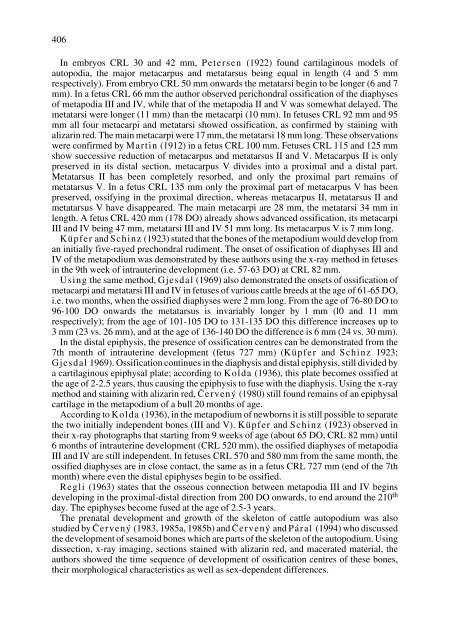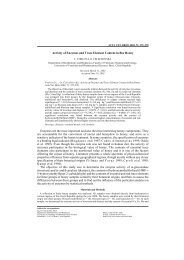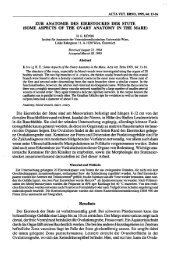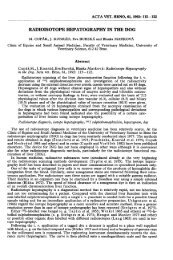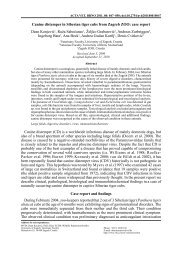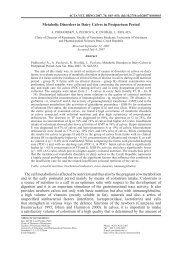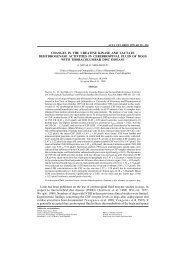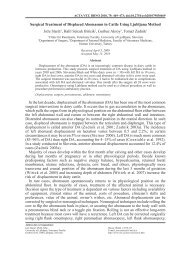Prenatal Development of Metacarpus and Metatarsus of Cattle
Prenatal Development of Metacarpus and Metatarsus of Cattle
Prenatal Development of Metacarpus and Metatarsus of Cattle
Create successful ePaper yourself
Turn your PDF publications into a flip-book with our unique Google optimized e-Paper software.
406<br />
In embryos CRL 30 <strong>and</strong> 42 mm, Petersen (1922) found cartilaginous models <strong>of</strong><br />
autopodia, the major metacarpus <strong>and</strong> metatarsus being equal in length (4 <strong>and</strong> 5 mm<br />
respectively). From embryo CRL 50 mm onwards the metatarsi begin to be longer (6 <strong>and</strong> 7<br />
mm). In a fetus CRL 66 mm the author observed perichondral ossification <strong>of</strong> the diaphyses<br />
<strong>of</strong> metapodia III <strong>and</strong> IV, while that <strong>of</strong> the metapodia II <strong>and</strong> V was somewhat delayed. The<br />
metatarsi were longer (11 mm) than the metacarpi (10 mm). In fetuses CRL 92 mm <strong>and</strong> 95<br />
mm all four metacarpi <strong>and</strong> metatarsi showed ossification, as confirmed by staining with<br />
alizarin red. The main metacarpi were 17 mm, the metatarsi 18 mm long. These observations<br />
were confirmed by Martin (1912) in a fetus CRL 100 mm. Fetuses CRL 115 <strong>and</strong> 125 mm<br />
show successive reduction <strong>of</strong> metacarpus <strong>and</strong> metatarsus II <strong>and</strong> V. <strong>Metacarpus</strong> II is only<br />
preserved in its distal section, metacarpus V divides into a proximal <strong>and</strong> a distal part.<br />
<strong>Metatarsus</strong> II has been completely resorbed, <strong>and</strong> only the proximal part remains <strong>of</strong><br />
metatarsus V. In a fetus CRL 135 mm only the proximal part <strong>of</strong> metacarpus V has been<br />
preserved, ossifying in the proximal direction, whereas metacarpus II, metatarsus II <strong>and</strong><br />
metatarsus V have disappeared. The main metacarpi are 28 mm, the metatarsi 34 mm in<br />
length. A fetus CRL 420 mm (178 DO) already shows advanced ossification, its metacarpi<br />
III <strong>and</strong> IV being 47 mm, metatarsi III <strong>and</strong> IV 51 mm long. Its metacarpus V is 7 mm long.<br />
Küpfer <strong>and</strong> Schinz (1923) stated that the bones <strong>of</strong> the metapodium would develop from<br />
an initially five-rayed prechondral rudiment. The onset <strong>of</strong> ossification <strong>of</strong> diaphyses III <strong>and</strong><br />
IV <strong>of</strong> the metapodium was demonstrated by these authors using the x-ray method in fetuses<br />
in the 9th week <strong>of</strong> intrauterine development (i.e. 57-63 DO) at CRL 82 mm.<br />
Using the same method, Gjesdal (1969) also demonstrated the onsets <strong>of</strong> ossification <strong>of</strong><br />
metacarpi <strong>and</strong> metatarsi III <strong>and</strong> IV in fetuses <strong>of</strong> various cattle breeds at the age <strong>of</strong> 61-65 DO,<br />
i.e. two months, when the ossified diaphyses were 2 mm long. From the age <strong>of</strong> 76-80 DO to<br />
96-100 DO onwards the metatarsus is invariably longer by l mm (l0 <strong>and</strong> 11 mm<br />
respectively); from the age <strong>of</strong> 101-105 DO to 131-135 DO this difference increases up to<br />
3 mm (23 vs. 26 mm), <strong>and</strong> at the age <strong>of</strong> 136-140 DO the difference is 6 mm (24 vs. 30 mm).<br />
In the distal epiphysis, the presence <strong>of</strong> ossification centres can be demonstrated from the<br />
7th month <strong>of</strong> intrauterine development (fetus 727 mm) (Küpfer <strong>and</strong> Schinz 1923;<br />
Gjesdal 1969). Ossification continues in the diaphysis <strong>and</strong> distal epiphysis, still divided by<br />
a cartilaginous epiphysal plate; according to Kolda (1936), this plate becomes ossified at<br />
the age <strong>of</strong> 2-2.5 years, thus causing the epiphysis to fuse with the diaphysis. Using the x-ray<br />
method <strong>and</strong> staining with alizarin red, âerven˘ (1980) still found remains <strong>of</strong> an epiphysal<br />
cartilage in the metapodium <strong>of</strong> a bull 20 months <strong>of</strong> age.<br />
According to Kolda (1936), in the metapodium <strong>of</strong> newborns it is still possible to separate<br />
the two initially independent bones (III <strong>and</strong> V). Küpfer <strong>and</strong> Schinz (1923) observed in<br />
their x-ray photographs that starting from 9 weeks <strong>of</strong> age (about 65 DO, CRL 82 mm) until<br />
6 months <strong>of</strong> intrauterine development (CRL 520 mm), the ossified diaphyses <strong>of</strong> metapodia<br />
III <strong>and</strong> IV are still independent. In fetuses CRL 570 <strong>and</strong> 580 mm from the same month, the<br />
ossified diaphyses are in close contact, the same as in a fetus CRL 727 mm (end <strong>of</strong> the 7th<br />
month) where even the distal epiphyses begin to be ossified.<br />
Regli (1963) states that the osseous connection between metapodia III <strong>and</strong> IV begins<br />
developing in the proximal-distal direction from 200 DO onwards, to end around the 210 th<br />
day. The epiphyses become fused at the age <strong>of</strong> 2.5-3 years.<br />
The prenatal development <strong>and</strong> growth <strong>of</strong> the skeleton <strong>of</strong> cattle autopodium was also<br />
studied by âerven˘ (1983, 1985a, 1985b) <strong>and</strong> âerven˘ <strong>and</strong> Páral (1994) who discussed<br />
the development <strong>of</strong> sesamoid bones which are parts <strong>of</strong> the skeleton <strong>of</strong> the autopodium. Using<br />
dissection, x-ray imaging, sections stained with alizarin red, <strong>and</strong> macerated material, the<br />
authors showed the time sequence <strong>of</strong> development <strong>of</strong> ossification centres <strong>of</strong> these bones,<br />
their morphological characteristics as well as sex-dependent differences.


